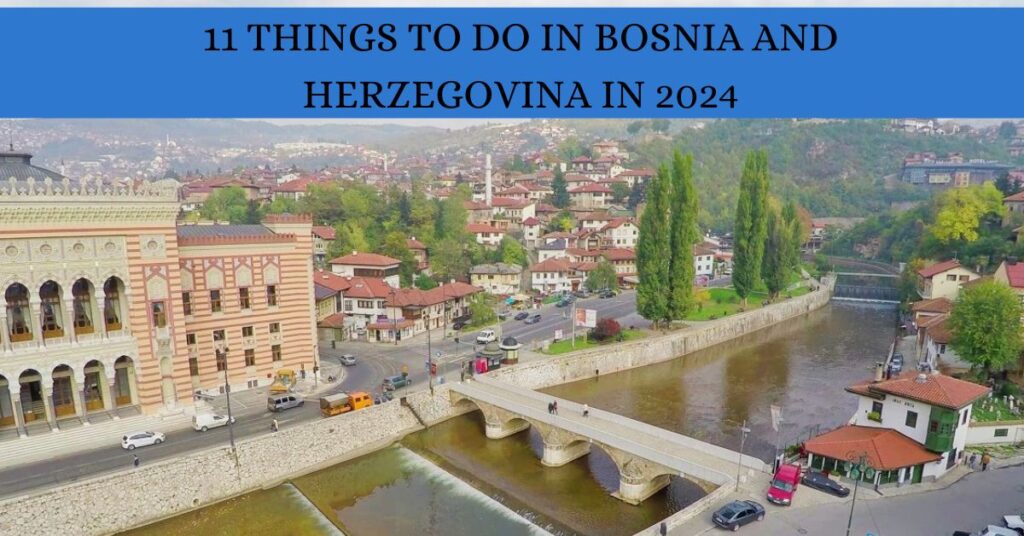Explore the best 11 things to do in Bosnia and Herzegovina in 2024, including historic landmarks, breathtaking landscapes, and captivating experiences. This enchanting destination, nestled in the heart of the Balkans, offers a tapestry of rich history, stunning landscapes, and warm hospitality. From Sarajevo’s vibrant energy to the serene beauty of its mountains and waterfalls, a trip to Bosnia promises an unforgettable journey.
The country offers a diverse range of experiences, from historic sites to natural wonders, catering to different traveller types. Whether you’re an adventurer, history buff, or nature lover, Bosnia has something special to offer. The top 11 things to do in Bosnia in 2024 include exploring the beautiful landscapes, experiencing the rich history, and experiencing the warm hospitality of the Balkans.
1) Exploring the Heart of Sarajevo
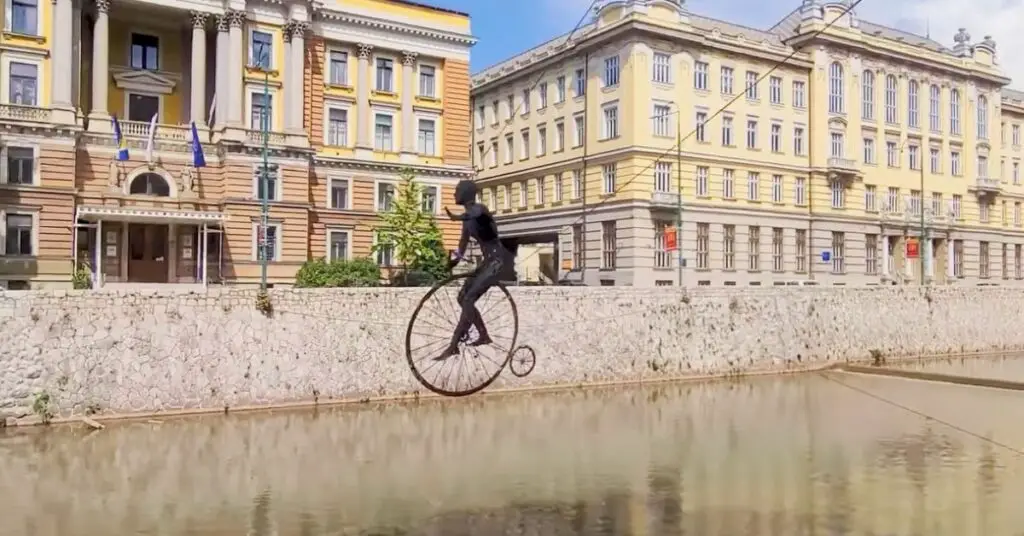
The Old Bazaar in Sarajevo, also known as Baščaršija, is a vibrant hub of history, culture, and commerce. Established in the 15th century during Ottoman rule, it offers a unique blend of sights, smells, and experiences that transport visitors back in time. The maze of cobbled streets transports visitors to a bygone era, reverberating with the echoes of Ottoman influence and centuries of trade. A guide is available to help you make the most of your exploration through the Old Bazaar.
The Sebilj Fountain, an 18th-century wooden fountain, serves as a meeting point for locals and tourists. The bazaar features Ottoman architecture, with its distinct Bosnian style attracting a variety of shops and stalls selling handmade crafts and spices. The Gazi Husrev-Beg Mosque, a masterpiece of Ottoman architecture, is a spiritual hub in Sarajevo. The bazaar is a living museum, with narrow cobblestone streets filled with traditional wooden shops and artisans. Visitors can also witness the art of copperware making and bargain for unique souvenirs.
2) A Visit to Sarajevo’s Tunnel of Hope
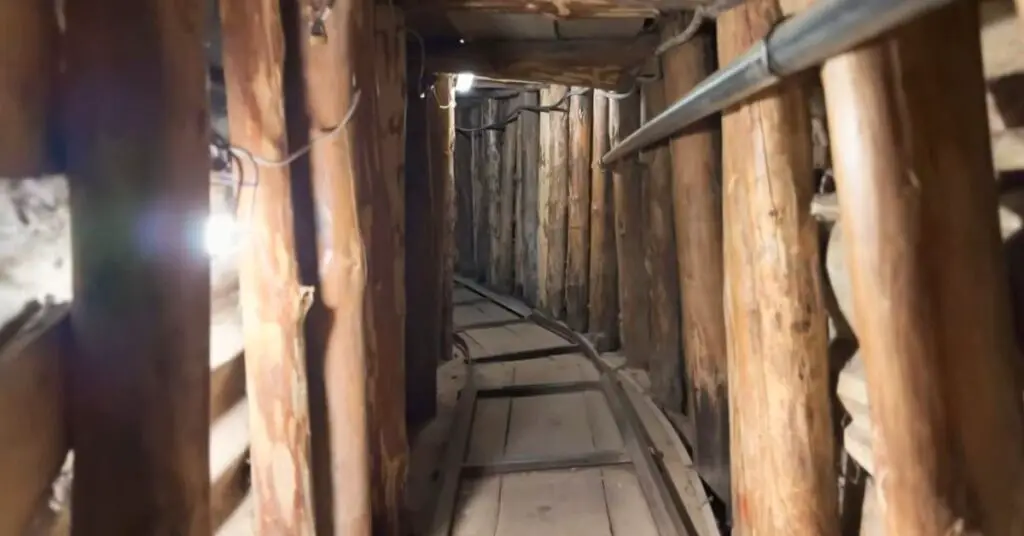
The Tunnel of Hope, located in Sarajevo’s Dobrinja suburb, is a 785-meter-long underground passage that symbolizes the resilience and perseverance of the Bosnian people during the Bosnian War. The tunnel, which served as a lifeline for besieged Sarajevo, was a symbol of hope and perseverance in the face of immense hardship. Exploring the tunnel is not just a historical journey but also a journey into the heart of the human spirit and the will to survive.
The Tunnel of Hope, also known as the Sarajevo Tunnel, was built between 1992 and 1995 during the Siege of Sarajevo. It served as a vital lifeline, providing essential supplies and enabling the movement of people. Today, the preserved tunnel is a museum that offers visitors a glimpse into wartime struggles and the determination to survive.
The museum features photographs, artifacts, and personal testimonies that recount the stories of those seeking refuge within its walls. The tunnel’s construction was a feat of human determination and ingenuity, providing a vital link to the outside world and embodying collective resilience. Visitors can also witness the daily life of Sarajevans during the siege, witnessing makeshift carts and cramped conditions within the tunnel. The preservation of the Tunnel of Hope is a testament to Bosnia’s commitment to preserving Bosnia’s history.
3) Stari Most: Mostar’s Timeless Icon
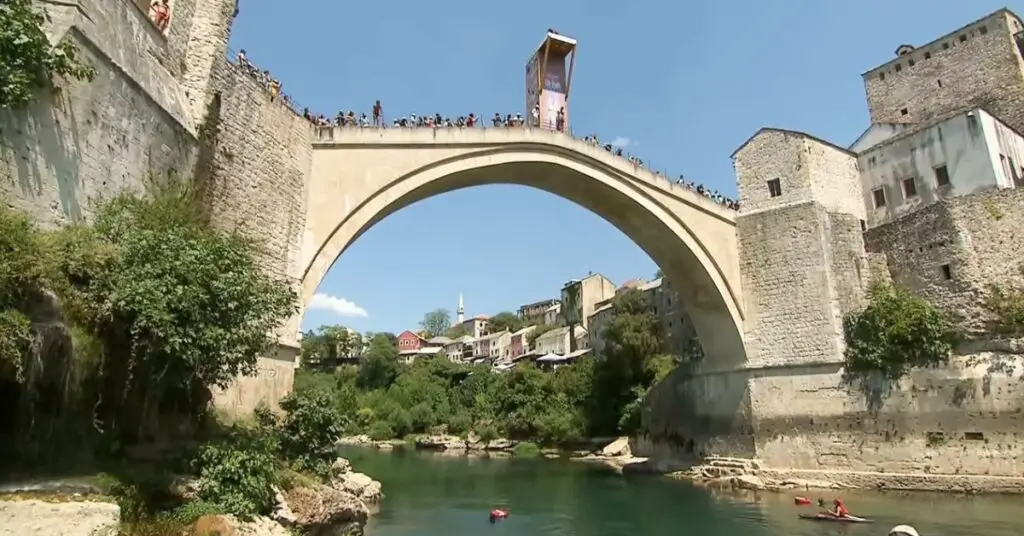
The Stari Most, also known as the Old Bridge, is a 16th-century Ottoman bridge in Mostar, Bosnia and Herzegovina. Built by Mimar Hayruddin in 1566, it spans the Neretva River and is a UNESCO World Heritage Site. The bridge, a single-arch stone structure, has been a symbol of Mostar’s history and has been rebuilt and reopened in 2004 as a symbol of hope and reconciliation.
Despite being destroyed in 1993 during the Bosnian War, the bridge was rebuilt and reopened in 2004 as a symbol of hope and reconciliation. Today, the Stari Most is a popular tourist destination, offering visitors the opportunity to walk, drive, or take a boat tour on the Neretva River. The bridge is also a popular spot for diving, with local divers competing for the title of Red Bull Cliff Diving World Series champion annually. The Stari Most is a must-see for visitors to Bosnia and Herzegovina, symbolizing the country’s rich history and culture and a testament to the resilience of its people.
4) 08 Reasons to Visit Blagaj Village in Bosnia
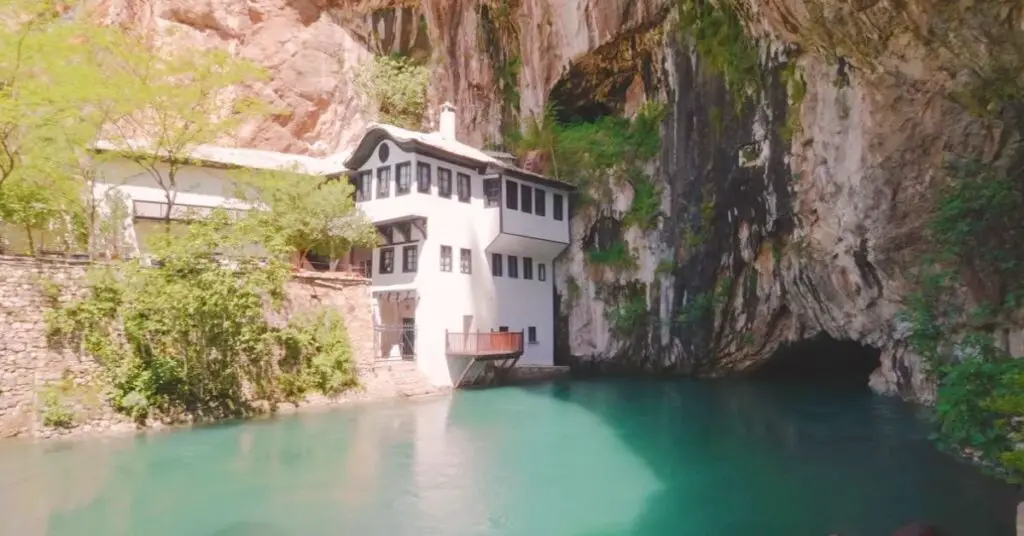
Blagaj, a charming village in Bosnia and Herzegovina, is known for its natural beauty and rich cultural heritage. Situated near Mostar, it offers serene landscapes, historical landmarks, and traditional charm. Located along the Buna River, it offers a tranquil escape for travellers seeking an authentic Bosnian experience. A virtual journey to Blagaj is recommended.
Blagaj’s Highlights:
- Buna River Spring: One of Europe’s largest and most powerful karst springs, surrounded by lush greenery.
- Dervish Monastery (Blagaj Tekke): A 600-year-old Sufi monastery with a blend of Ottoman and Mediterranean architecture.
- Boat Ride on the Buna River: A serene experience amidst the calm waters of the Buna River Spring.
- Riverside Dining: Enjoy traditional Bosnian dishes at riverside restaurants with panoramic views.
- Explore the Old Town: Discover the village’s historic ambiance with its narrow cobblestone streets and well-preserved Ottoman architecture.
- Buna River Promenade: A serene backdrop for exploration with its soothing river sounds and cliff views.
- Cave of Hercegovacka Gracanica: A unique underground experience with impressive stalactites and stalagmites.
- Photography Opportunities: Capture the reflection of the Tekke in the Buna River, the quaint streets of the old town, and the vibrant colors of the surrounding nature.
5) Hiking the Majestic Bosnian Mountains
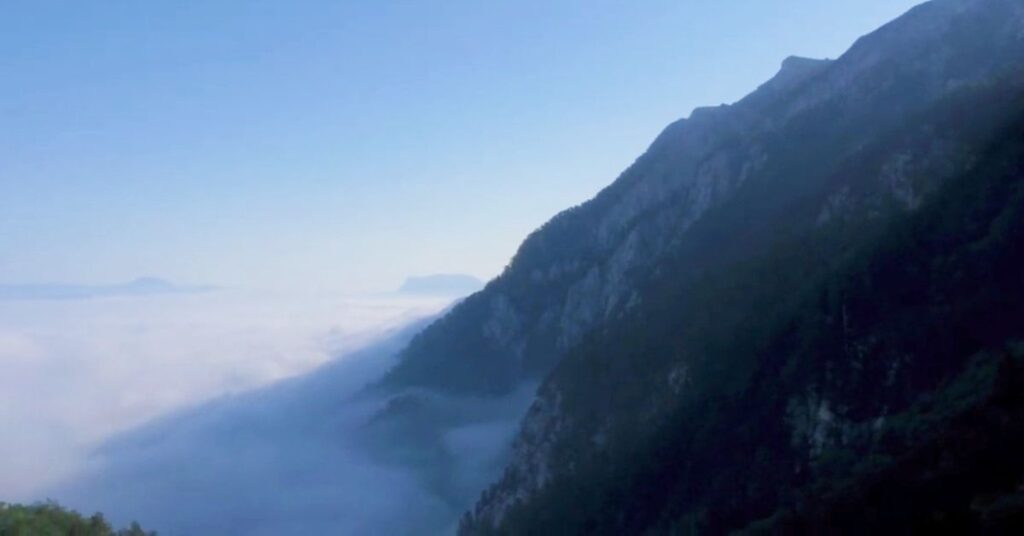
Bosnia and Herzegovina, located in the Dinaric Alps, is a paradise for hiking enthusiasts due to its diverse landscapes, rich history, and warm hospitality. The Bosnian Mountains, part of the Dinaric Alps, offer a variety of trails through valleys, alpine meadows, and rugged peaks, making it an ideal destination for those seeking breathtaking scenery and adventure.
(a) Mountain of Prenj: Reaching the Peak
- Challenge: Strenuous
- Distance: 11 kilometers (loop)
- Elevation gain: 1,800 meters
Mount Prenj, Bosnia’s highest peak, offers panoramic views and a sense of achievement, with a WWII memorial and an observation tower encompassing Montenegro and Croatia.
(b) Perucica: Wonderland of Waterfalls
- Challenge: Moderate
- Distance: 8 kilometers (loop)
- Elevation gain: 200 meters
Explore Sutjeska National Park’s emerald embrace on the Perucica trail, traversing wooden bridges and meandering along the Sutjeska River, culminating in the thundering Perucica Waterfall.
(c) Trebević: The Monitoring Deck of Sarajevo
- Challenge: Moderate to strenuous (depending on route)
- Distance: Varies (multiple trails)
- Elevation gain: Varies
Trebević offers a tranquil escape from Sarajevo’s urban bustle, offering stunning views of the city from its pine-scented forests and abandoned bobsled tracks.
(d) Blidinje: Lake and Mountain Views
- Challenge: Moderate
- Distance: 8 kilometers (loop)
- Elevation gain: 500 meters
Explore Blidinje Lake’s serene beauty on a circular trail, ascending through beech forests and enjoying the serene turquoise lake’s vistas of the Zelengora mountain range.
(e) The capers at the Canyon: Hajdučka Vrata
- Challenge: Strenuous
- Distance: 8 kilometers (loop)
- Elevation gain: 800 meters
Explore the thrilling Hajdučka Vrata canyon, a thrilling destination for adrenaline seekers, navigating through a narrow gorge, scaling sheer cliffs, and showcasing stunning vistas.
6) Visit Jajce’s Waterfall and Fortress
Jajce, located in central Bosnia, is a town known for its natural wonders and historical landmarks. Two must-see attractions are the Pliva Waterfall and the Jajce Fortress, each offering a unique glimpse into the town’s rich heritage and breathtaking beauty. Visitors can explore the Jajce Waterfall and its enduring beauty.
(a) Pliva Waterfall:
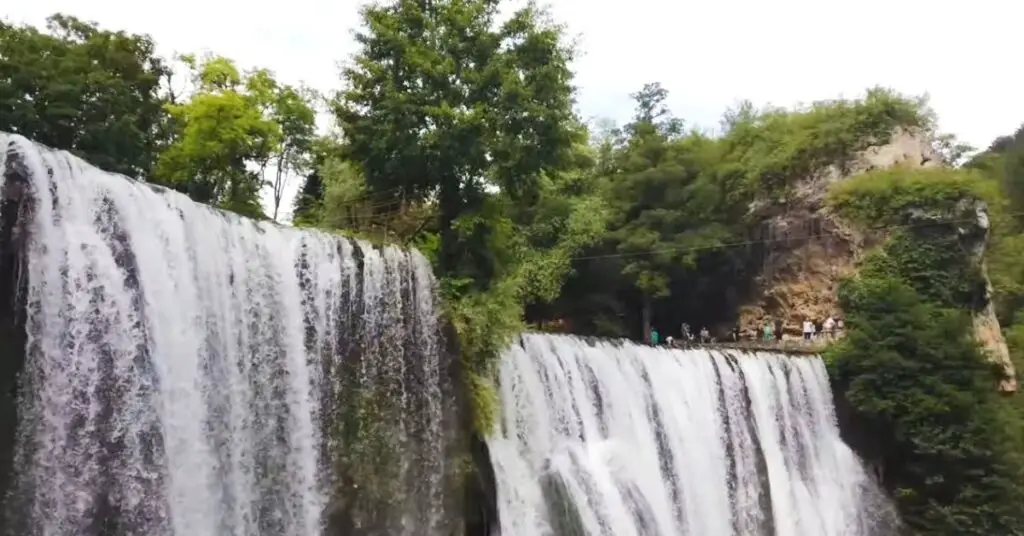
Pliva Waterfall is a stunning 22-meter cascade of emerald waters, surrounded by lush greenery and a rainbow of mist. Accessing the waterfall is easy through a scenic paved path or a boat ride on the Pliva River. Beyond the waterfall, visitors can explore trails leading to hidden grottoes, charming watermills, and cascading streams. They can also enjoy a picnic or dip their toes in the cool waters for a refreshing break.
(b) The Jajce Fortress:
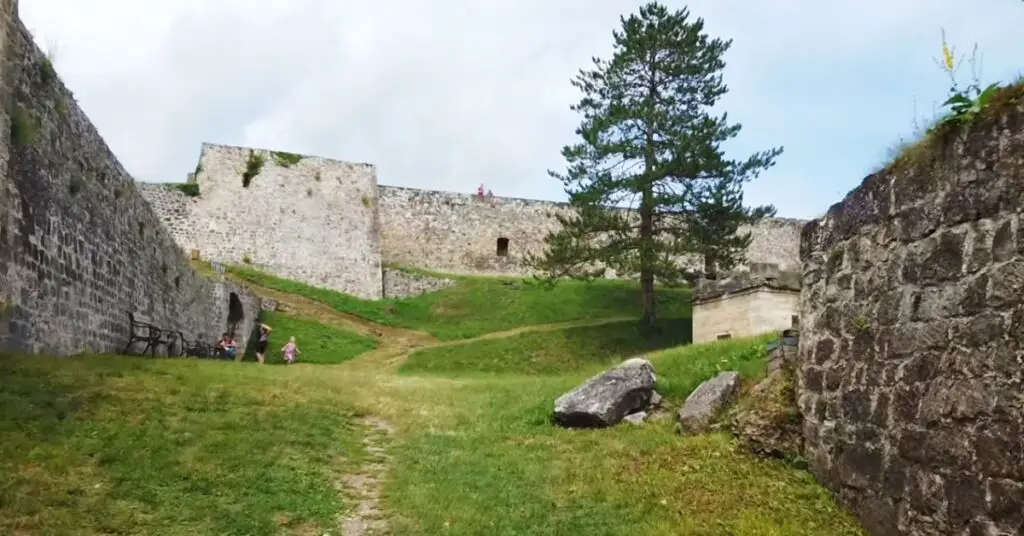
The Jajce Fortress, built in the 14th century, is a historical guardian of Jajce, a town located on a rocky outcrop. It served as a royal stronghold for Bosnian kings and witnessed significant events in the nation’s past. Visitors can explore the fortress grounds, explore the ramparts, and climb the Kastel tower to imagine the lives of soldiers and royalty who once lived there.
7) Tour the Bosnian Pyramids
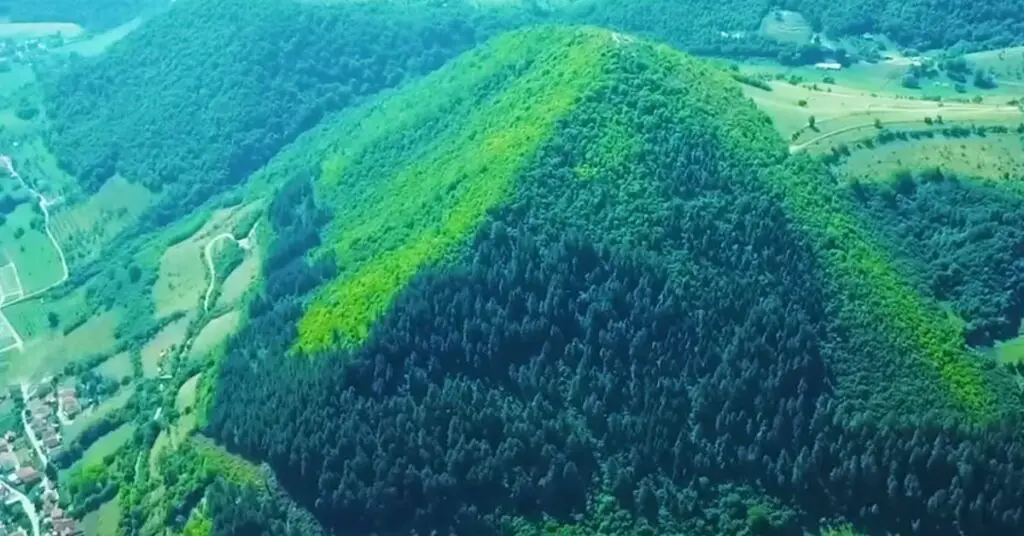
The Bosnian Pyramids, a unique archaeological discovery in Bosnia and Herzegovina, have sparked debate and fascination among travelers. Despite being presented as ancient, the scientific community considers them to be natural formations. A virtual tour explores the enigmatic complex in Visoko.
The Bosnian Pyramids, discovered by Bosnian researcher Semir Osmanagić in 2005, are a series of pyramid-shaped hills near Visoko. The primary pyramids are the Pyramid of the Sun, the Pyramid of the Moon, and the Pyramid of the Dragon. The Sun is the largest and most controversial, with its architectural marvel and panoramic views of the Visoko Valley. The moon, adjacent to the sun, is believed to emit specific energy fields.
Archaeological excavations are ongoing, and guided tours offer insights into the discoveries. The Dragon, also known as the Pyramid of Love, adds symbolism to the archaeological landscape. Underground explorations include the Ravne Tunnels, believed to connect the pyramids and hold energetic properties. Ravne Park offers a serene atmosphere for relaxation and contemplation. Archaeological conferences and events provide valuable insights into the ongoing research.
8) Relax at Vrelo Bosne
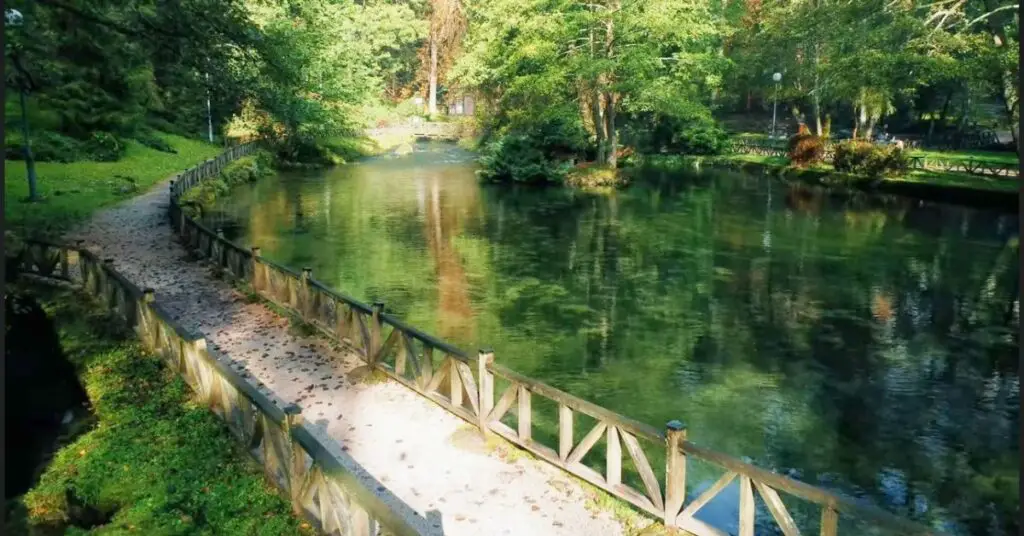
Vrelo Bosne, also known as the Spring of the Bosna, is a protected natural monument and park located just outside Sarajevo, Bosnia and Herzegovina. The park is home to the source of the Bosna River, a lake, waterfalls, and forests. It has been a popular destination for centuries, with its first recorded mention dating back to the 14th century. In the 19th century, it became a popular spot for picnics and outings for Sarajevo residents. The park was also a favorite destination for the Austro-Hungarian nobility, who built villas in the area.
Natural features of Vrelo Bosne include the Bosna River, a lake popular for swimming and fishing, several waterfalls, and forests, including the Vlašić Forest, one of the largest in Bosnia and Herzegovina. Activities to do at Vrelo Bosne include swimming in the lake, hiking on various trails, picnicking in picnic areas, and dining at various restaurants and cafes. The park offers a serene escape for those seeking relaxation and connection with nature.
9) Explore Sutjeska National Park
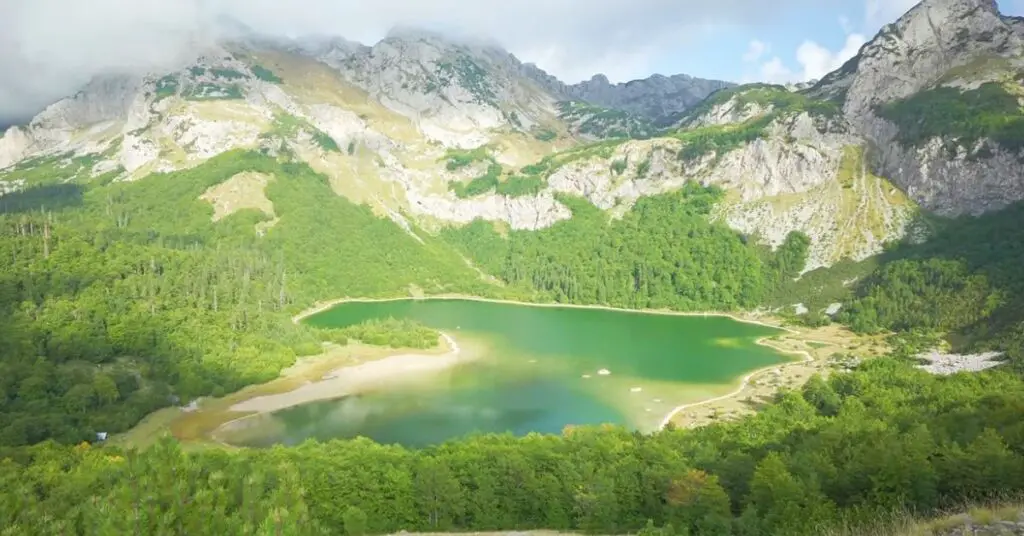
Sutjeska National Park, Bosnia and Herzegovina’s oldest national park, offers a diverse range of landscapes, including towering peaks, lush valleys, glacial lakes, and canyons. With over 16,000 hectares, it’s a perfect destination for nature lovers, adventure seekers, and history buffs. The park’s rich natural heritage and pristine wilderness make it a must-visit for outdoor enthusiasts and history buffs alike.
Highlights of Sutjeska National Park:
- Mount Maglić: The highest peak in Bosnia and Herzegovina, reaching 2,386 meters.
- Perćevina Lake: A serene oasis with boat rides, swimming, and shore relaxation.
- Skakavac Waterfall: A 75-meter waterfall with breathtaking views and a refreshing pool.
- Tjentište: A charming village with WWII memorials, museums, traditional Bosnian houses, and peaceful atmosphere.
- Tara River Canyon: A deep canyon offering rafting, kayaking, and canoeing opportunities.
- Mlimlje National Park: Bordered by Sutjeska National Park, offering hiking, waterfalls, and cave exploration.
10) Explore The War Childhood Museum in Sarajevo
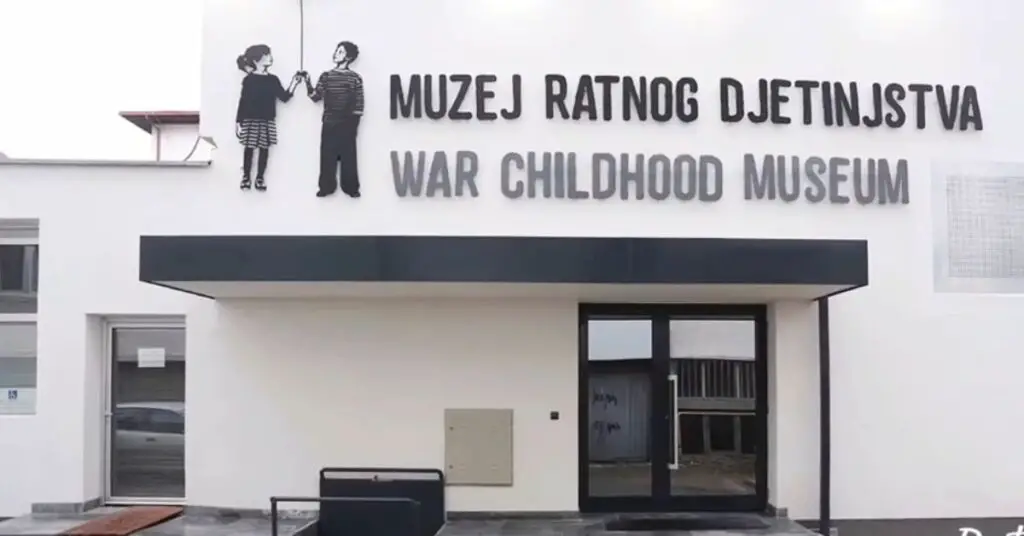
The War Childhood Museum in Sarajevo, a city known for its resilience, is a testament to the experiences of children who grew up during the Bosnian War (1992–1995). The museum focuses on individual stories rather than military history, showcasing the courage, hope, and enduring spirit of childhood and highlighting the lasting impact of the conflict on the lives of the children.
The War Childhood Museum, founded in 2017, is dedicated to preserving and sharing the stories of individuals who spent their formative years during the war. The museum features an exhibition of personal items, such as toys, schoolbooks, clothing, and diaries, that tell stories of resilience and adaptation. Interactive displays, such as touchscreens and multimedia presentations, allow visitors to explore the stories behind the items.
Digital storytelling and oral histories are also featured, providing firsthand accounts of the challenges faced during wartime. Art installations and exhibits, such as paintings and sculptures, express the emotional depth of wartime experiences. The museum also engages in educational programs to raise awareness about the impact of war on children and foster empathy among younger generations. Temporary exhibitions and events provide fresh perspectives and opportunities for continued reflection on war childhood.
11) Uncovering the Secrets of Pocitelj
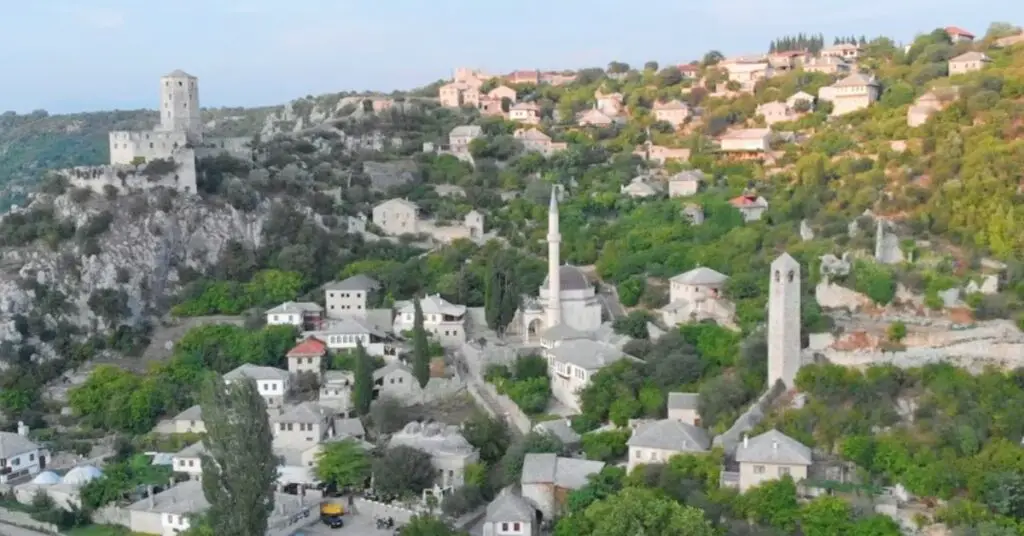
Pocitelj, a medieval town in Bosnia and Herzegovina, is a UNESCO World Heritage Site that offers a glimpse into a bygone era. The town is nestled along the banks of the Neretva River, offering visitors a glimpse into a world where time seems to have stood still. The town’s cobblestone streets, lined with traditional Ottoman houses and colorful flowers, transport visitors back in time.
The imposing towers of Kula Široki and Kula Gazanferija, remnants of medieval fortifications, narrate stories of battles and conquests. The Mehmed Paša Sokolović Mosque, built in the 16th century, is a masterpiece of Ottoman architecture. The Haji-Alibegova Mosque, a smaller yet equally captivating structure, also adds to the town’s charm. Počitelj’s beauty extends beyond its historical treasures, offering breathtaking panoramic views of the Neretva River. Visitors can indulge in local culinary delights, such as traditional Bosnian fare and the specialty “jagnjetina ispod peke.” Počitelj also offers unique experiences, such as visiting local shops selling handmade crafts and attending cultural events.
FAQs
-
What are the best times to visit Bosnia?
Both the spring (April–June) and autumn (September–October) bring beautiful weather and colorful scenery. Summer (July–August) can be hot and congested, but winter (December–February) can be charming and covered in snow.
-
Which currency is in use in Bosnia?
The Bosnian marka (BAM) is the official currency. In tourist areas, euros are also commonly used.
-
How can I have an overview of Bosnia’s rich history?
Visit historical fortresses, the Tunnel of Hope, the War Childhood Museum, and other sites and landmarks to fully immerse yourself in history.
-
Does Bosnia offer any outdoor activity opportunities?
Yes, Bosnia has a variety of outdoor experiences. Explore the Bosnian Pyramids, go sailing on Jablanica Lake, or go hiking in the country’s mountains.
-
Can I take in Bosnia’s breathtaking scenery?
Of course! Discover the splendor of nature in locations like Sutjeska National Park, Pliva Lakes, and Vrelo Bosne, which provide breathtaking scenery and outdoor pursuits.
-
What are the most notable aspects of Jajce culture?
For a thorough cultural experience, visit St. Mary’s Church, the Museum of the AVNOJ, and cultural events held within Jajce Fortress.
-
As a comprehensive experience, are there any tours available with guides?
Yes, if you want to learn more about the history and significance of each place, especially when visiting historical sites, you should think about taking a guided tour.
-
Is it wise to consult the weather forecast before scheduling any outdoor activities?
Yes, in order to ensure a safe and enjoyable experience, it is advised to check the weather forecast, particularly when planning outdoor activities like sailing or hiking.
-
Does Bosnia offer any opportunities for birdwatching?
Absolutely, take pleasure in birdwatching near Jablanica Lake and other natural areas to observe the variety of bird species that call Bosnia’s tranquil landscapes home.
-
How can I get the most out of my 2024 trip to Bosnia?
To truly appreciate Bosnia’s beauty, make a plan, broaden your horizons by visiting historical, cultural, and natural sites, and interact with the local populace.
